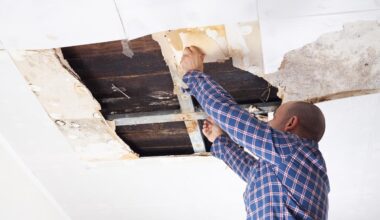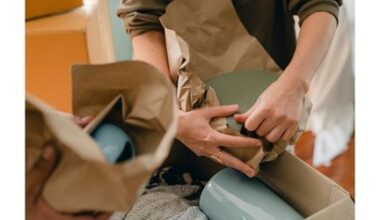If you want an all-natural, durable, and beautiful floor for your home, you’ll need to know how to install linoleum flooring. We’ll walk you through the entire DIY process it takes to install linoleum flooring on concrete, plywood, and stairs or bathroom. Before we begin, you should be aware that linoleum and vinyl are not the same things. Even though their installation techniques are identical, linoleum flooring is water-resistant, whilst vinyl flooring is waterproof.
Linoleum is a natural product created from pine resin, linseed oil, jute backing, and wood dust. It’s also great for high-traffic areas like hallways and entryways because of its scratch resistance.
Related Articles: BEST VACUUM FOR TILE FLOORS: 5 Top Picks In 2022
Linoleum has a backing and so does not require an underlayment. It can be put over an existing smooth and flat floor. They can also be put over tiles with sufficient grout. Linoleum is available in 7-foot wide rolls of tiles. These sheets are affixed to the floor. However, they can also be installed on the floor without being glued. Let us get started on how to install linoleum flooring on concrete, plywood, and stairs or bathroom.
How to Install Linoleum Flooring
Here are some of the items you will require for the installation. A notched trowel, a moist rag, a floor roller, a jigsaw, a utility knife, chalk line, caulk, and tile glue are all required. Follow the instructions below to learn how to install linoleum flooring correctly.
#1. Measure the Room
Grab a tape measure and make a note of the room’s dimensions so you know how much linoleum you’ll need. When measuring, be sure you buy about 10% more linoleum flooring than the actual proportions.
#2. Allow Linoleum to Acclimate
Linoleum normally takes 24 to 48 hours to acclimatize to the surroundings of your home. Because linoleum might slightly expand and contract, it’s vital to let it settle before laying it down. When you start installing linoleum flooring, leave an extra 14-inch on each side to allow for expansion and contraction.
#3. Take out all the furniture, baseboards, appliances, and doors.
Before installing linoleum flooring, you should remove any furniture, baseboards, appliances, and doors. To remove the baseboards, you’ll need a hammer or a pry bar, as well as a screwdriver. Furthermore, when laying linoleum floors, you should avoid working around doorways.
#4. Repair and level the existing floor
Linoleum flooring does not necessarily require an underlayment because it has a backing, but when you install it, you must ensure that your current floor is level and free of pocks and bumps. If you don’t fix a bump right away, you’ll notice it later, and the linoleum may fracture. Before proceeding, use a level to ensure that the floor is level.
Related Articles: Great Northern Insurance Agency| Best 2022 Reviews
#5. Draw cut lines on the linoleum
Isn’t it true that you should measure twice and cut once? When it comes to putting linoleum flooring, the same DIY principle applies. To avoid mistakes, mark cut lines on the linoleum before you begin cutting. Make sure your lines are straight by using a tape measure.
#6. Cut linoleum
A utility knife will be enough for cutting linoleum flooring, but a jigsaw is also useful. When cutting with a utility knife, make sure you score the flooring first.
#7. Lay linoleum
Begin by applying flooring adhesive with a notched trowel to the subfloor or existing floor. Flooring adhesive and a notched trowel can be purchased from a home improvement or hardware store. Before installing the linoleum flooring, apply a thin, even application of flooring adhesive. With a moist rag, remove extra flooring adhesive as you lay linoleum flooring.
#8. Roll Linoleum and apply sealant
After laying the linoleum, use a floor roller to smooth it out. You probably don’t want to buy a floor roller for a one-time project, so see if you can rent one from a hardware or home improvement store. Sealant should be applied between seams to avoid flaking and water damage. Linoleum sealant can assist in providing a good shiny surface to the floor.
#9. Allow the floor to sit for a day before replacing any items that were removed.
Allow the flooring adhesive to do its job with the linoleum flooring by not allowing any foot activity on the floor for the full day. After a day, you can start replacing the appliances, doors, baseboards, and furnishings that were removed from the space.
Related Articles: SPECIAL ASSESSMENT TAX: Definition & How It Works In Real Estate
#10. Caulk the Floor as Necessary
As you reassemble the room, some locations may require caulking. Pay close attention to baseboards, toilets, and other locations around water-using appliances. The best caulk to use is latex or acrylic latex-based caulk.
How to Install Linoleum Flooring on Concrete
There are several steps to follow on how to install linoleum flooring, especially when placing it over an existing concrete floor. Installing linoleum flooring on concrete will provide you with a gorgeous, environmentally sustainable floor. Here are the basics of how to install linoleum flooring on concrete.
- Sweep the concrete floor to remove big dirt and debris. To eliminate debris that sweeping with a broom may miss, vacuum the floor.
- Protect your eyes by using safety goggles. Long pants, a long-sleeved shirt, and gloves are required.
- In a 5-gallon bucket, combine 1/2 cup of trisodium phosphate and 2 gallons of boiling water. TSP is available at hardware stores and home improvement centers. Scrub the concrete floor with a mop and TSP, working in tiny sections, to remove any grease, oil, paint, or grime.
- Rinse the area with warm, clean water. Before going on to the next location, wipe off any surplus water. Allow the floor to dry completely. Depending on the temperature and humidity, drying times will vary.
Related Articles: LAMBORGHINI INSURANCE COST: Rates and Quotes In 2022
- Fill any cracks and holes in the concrete floor with a pre-mixed floor repair suited for use on concrete. Smooth the surface of the mended area with a putty knife or the straight edge of a trowel, feathering the edges to meld the repair into the surrounding concrete. For any particular application considerations or drying times, consult the manufacturer’s instructions.
- Fill a 5-gallon bucket halfway with water and add floor leveling compound to make a milkshake-like consistency. Check the leveling compound’s instructions for the optimum water-to-powder ratio for the greatest results.
- Use the leveling compound to fill any depressions on the concrete floor. To mix the product with the surrounding floor, feather the compound with a trowel or putty knife along the borders of the depressions. The drying time will vary depending on the product manufacturer’s recommendations and the weather.
- Wrap a block of wood in coarse-grit sandpaper. Cover your lips and nose with a dust mask. To prepare the concrete surface, sand the whole surface of your floor. This ensures that the linoleum adhesives you employ will bond with the concrete. Remove any concrete dust from the floor using a vacuum.
Related Articles: Mazzola Insurance: Best Policy Review 2022
- Cut many 2-foot-by-2-foot pieces of clear 6-mil plastic sheeting. Place the plastic on various areas of the concrete floor. Tape the plastic to the floor on all four sides with duct tape.
- Leave the plastic alone for 24 to 48 hours. Before installing the linoleum floor, call a professional who specializes in concrete moisture concerns if the concrete becomes darker beneath the plastic or if condensation occurs on the underside of the plastic.
- Use a humidity sensor to check the humidity level in the room. Install it till the humidity level is between 40% and 60% before installing the linoleum. Install your linoleum flooring on your concrete once the room has reached the right humidity level.
How to Install Linoleum Flooring in a Bathroom
Installing linoleum flooring in your bathroom is a low-cost upgrade. Linoleum flooring is available in a variety of shapes and colors and is simple to install in your bathroom. Linoleum is typically sold in sheets. Tiles are presently the most popular technique to install linoleum flooring in your bathroom. Although some are self-stick, adding an adhesive is a smart idea. Before you begin, read the manufacturer’s installation instructions. Here are the steps to installing linoleum flooring in your bathroom:
Step 1: Take a floor measurement.
Take measurements of all of your floor’s dimensions. It is beneficial to make a sketch. Determine how much square footage you’ll need for the room.
Step 2: Purchase the linoleum
Linoleum is typically sold in sheets. Tiles, some of which are self-stick, are presently the most frequent way to install linoleum. You should follow the manufacturer’s instructions and think about utilizing an adhesive.
Related Articles: Canal Insurance Reviews 2022| All you need to know
Step 3: Take out the toilet
First, cut off the toilet’s water supply. Remove the nuts that are holding the toilet to the floor and pull the toilet away from the floor. This will cause the seal to crack, so it’s a good idea to get a new toilet seal before you begin. Make a clean sweep of the floor beneath where the toilet was previously positioned.
Step 4: Take away the baseboards, floor moldings, and T-moldings.
Remove the reducer or T-molding from the space beneath the doors near the bathroom door. Pry the baseboards up and carefully remove them so they can be reused.
Step 5: Take out the old tile
Pull up and remove all of the old tiles from the bathroom with a putty knife. Remove the tiles and scrape away any excess glue from the floor. To remove any dust from the floor, sweep or vacuum it.
Step 6: Mark the centerline
If you’re laying sheet linoleum, double-check your measurements before cutting. Linoleum tiles are significantly easier to install and more durable if a proper adhesive is used. Draw a chalk line through the center of the floor.
Step 7: Install the tiles.
Smooth adhesive onto the floor with a serrated trowel. Now, center the first line of tiles and start laying the tiles. Then butt the other tiles up to the first row.
Step 8: Cut the tiles
Install the tiles around the border of the room and the toilet opening. Plan it such that the cuts are made under the counter’s overhang. Cut close to the walls so that the baseboard trim covers the edges.
Step 9: Seal the edges
Caulk all of the edges so that water does not get under the tiles and cause them to lift from the floor. Make sure to caulk well around the toilet opening and bathtub.
Step 10: Reapply the trim
Replace the trim and moldings with nails. Return the door guard to its original position. Install the toilet again, this time with a new seal. Clean the tile by hand with a sponge to reveal any adhesive or caulk that needs to be removed. Take pleasure in your new bathroom flooring. The only thing it requires is a damp mop and a light cleaner to keep it clean.
Related Articles: FOURPLEX: Guide for Investors
How to Install Linoleum Flooring on Plywood
Plywood is one type of floor onto which you can install linoleum flooring. The type of plywood on the floor, on the other hand, is critical. To ensure that the linoleum doesn’t have soft patches or bubbles caused by adhesive issues, use Type 1 luan plywood or underlayment-grade plywood. It is vital to have a smooth, flat surface that will accept the glue. This technique will differ based on the room and whether you are installing sheet or lock linoleum flooring. Follow the steps below to install linoleum flooring on plywood:
Preparation
- If the floor is made of low-grade luan plywood or other inferior plywood, use a paint-on moisture barrier. You can also cover the floor with 4 to 6 mm thick plastic sheeting.
- Store the linoleum in the room where it will be installed for a day or two before installation. This acclimates the linoleum to the typical room temperature.
- Remove the doors after disconnecting the hinges using a screwdriver.
- The entire floor should be vacuumed and/or swept.
- Measure the floor’s size and add three inches to your measurements.
Installation
- Step 1: Spread the linoleum across the entire floor (this may require at least two persons) and ensure that it covers the entire surface. Because the linoleum sheet(s) were cut larger than necessary, they should curl up towards the wall.
- Step 2: Using a utility knife, cut and trim the excess linoleum until it is flush against the molding between the floor and the walls.
- Step 3: Pull back half of the linoleum and tape it down so that it remains folded over itself in one big loop.
Related Articles: CRAWL SPACE DEHUMIDIFIER: 5 Best Picks In 2022
- Step 4: Spread the adhesive over the unprotected plywood subfloor. Check all manufacturer’s directions for the application of the adhesive.
- Step 5: Unroll and reposition the linoleum on the covered floor, applying pressure from the center out to paste it down. This may necessitate the use of a 100 lb. roller of some kind.
- Step 6: Roll up the linoleum, apply the adhesive, and paste down the linoleum for the other half.
- Step 7: If necessary, reinstall the doors.
How to Install Linoleum Flooring on Stairs
Linoleum flooring on stairs is not as difficult to install as it is on floors. The only distinction is that the flooring material is installed on the rise or vertical portion of the stairs. Here are some basic steps on how to install linoleum flooring on stairs.
Step 1: Preparation of the subfloor
Linoleum must be laid on a flat, structurally sound subfloor. Its subfloor is built of concrete, OSB, or plywood. If there are any fractures or problems in the concrete subfloor, make sure to repair them first. After that, rinse the area with water and let it dry. Cut plywood can also be used to prepare the subfloor. The plywood will offer a smooth surface that will efficiently attach to the linoleum flooring material. Install plywood pieces on the staircase to provide a subfloor foundation. To remove dust and debris from the surfaces, clean them.
Step 2: Measure and cut the necessary linoleum
Separately, measure the horizontal and vertical areas of the stairs and transfer the measurements to the linoleum sheets. To guarantee a proper fit, keep the dimensions as accurate as possible. Proceed with the cutting after transferring the measurements. Make sure to make as many straight cuts as possible. When cutting, use a meter stick or another robust item with a straight edge as a guide. Always include a margin of error in your measurements to allow for revisions.
Step 3: Installing the linoleum sheets
Place the cut sheets on the stairwell surfaces to see if they fit or not. At this time, do not add adhesive. If required, make changes to the cutbacks. Remove the sheets and begin correctly installing linoleum flooring on the stairs.
Step 4: Putting the Sheets Together
Apply linoleum sheet glue to the first stair rise, starting at the top of the stairs. For this step, you’ll need a trowel or a putty knife. After that, firmly press the cut linoleum sheet. Continue with the horizontal section of the stairs in the same manner. The trick is to cover every surface of the stairs with linoleum, one step at a time.
Related Articles: HOW OFTEN DO CONTINGENT OFFERS FALL THROUGH?
Linoleum is a sort of flooring material that has natural water-proofing characteristics as well as other advantages. When selecting whether to install linoleum flooring on stairs, keep in mind that it is not advised for long stairwells due to their slickness when damp. Install linoleum flooring on concrete, bathroom or plywood, and short stairs
Conclusion
We’ve already covered how to install linoleum flooring on concrete, in the bathroom, on plywood, and on the stairs. Linoleum flooring is a good alternative to hardwood flooring if you’re on a budget. Because linoleum flooring is environmentally friendly, you are also contributing to the well-being of the world.
Do you have linoleum flooring on your concrete, bathroom, plywood, and stairs, or are you intending to install it? Tell us in the comments. Please share this post with your friends so that they can benefit from my knowledge on how to install linoleum flooring in their houses.
Frequently Asked Questions
Does linoleum need to be glued down?
There’s no need for glue.
One form of linoleum flooring does not need adhesive to be installed. Tongue-and-groove boards installed on the floor interlock to form a solid floor above the subfloor. Because nothing links them to the floor beneath, they are commonly referred to as floating floors.
What do you put under linoleum flooring?
Plywood underlayment is a thin plywood layer that is often used beneath resilient flooring materials like vinyl and linoleum sheets and tiles.
Is linoleum floor easy to install?
Though linoleum is relatively simple to install when compared to more expensive choices, it can provide distinct obstacles for people who are new to home repair.
What is the best adhesive for linoleum?
When it comes to attaching vinyl floors, acrylic-based adhesives are particularly efficient and sturdy. Acrylic-based adhesives are heat-resistant, can withstand temperature variations, and do not become brittle when exposed to moisture.
Related Articles:






